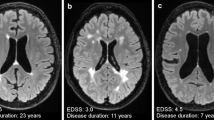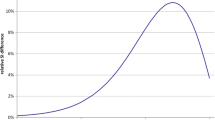Abstract
Serial gadolinium (Gd)-enhanced magnetic resonance imaging (MRI) was used to monitor the effect of mitoxantrone in ten patients with rapidly deteriorating multiple sclerosis (MS). MRI was performed as a baseline and thereafter at 1,3,6,9,12 and 24 months. The total number of Gd-enhancing lesions diminished from 169 at baseline to 10 after 1 year and to 5 after 2 years. This reduction and the percentage of follow-up MRI studies showing no Gd enhancement were more pronounced than in other MRI studies of the natural course of MS. Measured with quantitative neurological scales, only one patient showed deterioration after 2 years; nevertheless, the changes in MRI were much more marked than those observed clinically. Serial Gd-MRI therefore, seems necessary for documenting efficacy in future therapeutic trails.
Similar content being viewed by others
References
Thompson AJ, Miller D, Youl B, Mac-Manus D, Moore S, Kingsley D, Kendall B, Feinstein A, McDonald WI (1992) Serial gadolinium-enhanced MRI in relapsing/remitting multiple sclerosis of varying disease duration. Neurology 42: 60–63
Harris JO, Frank JA, Patronas N, McFarlin DE, McFarland HF (1991) Serial gadolinium-enhanced magnetic resonance scans in patients with early, relapsing-remitting multiple sclerosis: implications for clinical trials and natural history. Ann Neurol 29:548–555
McFarland HF, Frank JA, Albert PS, Smith ME, Martin R, Harris JO, Patronas N, Maloni H, McFarlin DE (1992) Using gadolinium-enhanced magnetic resonance imaging to monitor disease activity in multiple sclerosis. Ann Neurol 32:758–766
Miller DH, Rudge P, Johnson G, Kendall BE, MacManus DG, Moseley IF, Barnes D, McDonald WI (1988) Serial gadolinium enhanced magnetic resonance imaging in multiple sclerosis. Brain 111:927–939
Katz D, Taubenberger J, Raine C, McFarlin D, McFarland H (1990) Gadolinium enhancing lesions on magnetic resonance imaging: neuropathological findings. Ann Neurol 28:243
Bastianello S, Pozzilli C, Bernardi S, Bozzao L, Fantozzi LM, Buttinelli C, Fieschi C (1990) Serial study of gadolinium-DTPA MRI enhancement in multiple sclerosis. Neurology 40:591–595
Capra R, Marciano N, Cotti Cometti V, Vignolo LA, Bettinazioli M, Airo P, Cattaneo R, Gasparotti R, Moretti R (1992) Immunological and gadolinium-DTPA MRI evaluation of relapsing remitting multiple sclerosis. Acta Neurol Scand 86:342–345
Grossman RI, Braffman BH, Brorson JR Goldberg HI, Silberberg DH, González-Scarano F (1988) Multiple sclerosis: serial study of gadolinium-enhanced MR imaging. Radiology 169:117–122
Miller DH, Thompson AJ, Morrisey SP, MacManus DG, Moore SG, Kendall BE, Moseley IF, McDonald WI (1992) High dose steroids in acute relapses of multiple sclerosis: MRI evidence for a possible mechanism of therapetic effect. J Neurol Neurosurg Psychiatry 55: 450–453
Thompson AJ, Kermode AG, Wicks D, MacManus DG, Kendall BE, Kingsley DPE McDonald WI (1991) Major differences in dynamics of primary and secondary progressive multiple sclerosis. Ann Neurol 29:53–62
Kurtzke JF (1983) Rating neurological impairment in multiple sclerosis: an expanded disability status scale (EDSS). Neurology 33:1444–1452
Lublin FD, Lavasa M, Viti C, Knobler RL (1987) Suppression of acute and relapsing experimental allergic encephalomyelitis with mitoxantrone. Clin Immunol Immunopathol 45:122–128
Hortobagyi GN, Budzar AU, Marcus CE, Smith TL (1986) Immediate and long-term toxicity of adjuvant chemotherapy regimes containing doxorubicin in trials at M.D. Anderson Hospital and Tumor institute. CI Monogr 1:105–109
McDonald M, Posner LE, Dukart G, Scott SC (1985) A review of the acute and chronic toxicity of mitoxantrone. Fut Trends Chemother 6:443–450
Mauch E, Lambacher R, Rauer S, Wagner U, Niethammer R, Laufen H, Krapf H, Kornhuber AW, Kornhuber HH (1993) The course of multiple sclerosis under cyclophosphamide or mitoxantrone as compared with the spontaneous course of cortisone/ACTH. Neurology Psychiatry Brain Res 1:220–227
Mauch E, Kornhuber HH, Krapf H, Laufen H (1992) Treatment of multiple sclerosis with mitoxantrone. Eur Arch Psychiatry Clin Neurosci 242:96–102
Miller DH, Barkhof F, Berry I, Kappos L, Scotti G, Thompson AJ (1991) Magnetic resonance imaging in monitoring the treatment of multiple sclerosis: concerted action guidelines. J Neurol Neurosurg Psychiatry 54:683–688
González-Scarano F, Grossman RI, Galetta S, Atlas SW, Silberberg DH (1987) Multiple sclerosis disease activity correlates with gadolinium-enhanced magnetic resonance imaging. Ann Neurol 21:300–306
Kappos L, Gold R, Hofmann E, Grimminger V, Keil W, Künstler E, Radü EW (1991) Magnetic resonance imaging: contribution to early diagnosis and monitoring disease activity in therapeutic trials. In: Wiethölter H, Dichgans J, Mertin J (eds) Current concepts in multiple sclerosis. Elsevier, Amsterdam, pp 23–28
Barkhof F, Hommes OR, Scheltens P, Valk J (1991) Quantitative MR changes in GD-DTPA enhancement after highdose intravenous methylprednisolone in multiple sclerosis. In: Wiethölter H, Dichgans J, Mertin J (eds) Current concepts in multiple sclerosis. Elsevier, Amsterdam, pp 257–262
Isaac C, Li DKB, Genton M, Jardine C, Grochowski E, Palmer M, Kastrukoff LF, Oger J, Paty DW (1988) Multiple sclerosis: a serial study using MRI in relapsing patients. Neurology 38:1511–1515
Kastrukoff LF, Oger JJ, Hashimoto SA, Sacks SL, Li DK, Palmer MR, Koopmans RA, Petkau AJ, Berkowitz J, Paty DW (1990) Systemic lymphoblastoid interferon therapy in chronic progressive multiple sclerosis. I. Clinical and MRI evaluation. Neurology 40:479–486
Kesselring J, Miller DH, MacManus DG, Johnson G, Milligan NM, Scolding N, Compston DAS, McDonald WI (1989) Quantitative magnetic resonance imaging in multiple sclerosis: the effect of high dose intravenous methylprednisolone. J Neurol Neurosurg Psychiatry 52:14–17
Koopmans RA, Li DKB, Zhao GJ, Redekop WK, Paty DW (1992) MRI assessment of cyclosporin therapy of MS in a multi-center trial. Neurology 42 [Suppl 3] 210
Paty DW, Li DKB, MS/MRI Study Group, IFNB MS Study Group (1993) Interferon-beta-1b is effective in relapsing-remitting multiple sclerosis. II. MRI analysis results of a multicenter randomized, double-blind placebo control trial. Neurology 43:662–667
Willoughby EW, Grochowski E, Li DKB Oger J, Kastrukoff LF, Paty DW (1989) Serial magnetic resonance scanning in multiple sclerosis: a second prospective study in relapsing patients. Ann Neurol 25:43–49
Wicks DAG, Tofts PS, Miller DH, du Boulay GH, Feinstein A, Sacares A, Harvey I, Brenner R, McDonald WI (1992) Volume measurement of multiple sclerosis lesions with magnetic resonance imaging. Neuroradiology 34: 475–479
Hawkins CP, Mackenzie F, Tofts P, du Boulay EPGH, McDonald WI (1991) Patterns of blood-brain barrier breakdown in inflammatory demyelination. Brain 114:801–810
Kermode AG, Tofts PS, Thompson AJ, MacManus DG, Rudge P, Kendall BE, Kingsley DPE, Moseley IF, du Boulay EPGH, McDonald WI (1990): Heterogeneity of blood-brain barrier changes in multiple sclerosis: an MRI study with gadolinium-DTPA enhancement. Neurology 40:229–235
Milligan NM, Newcombe R, Compston DAS (1987) A double-blind controlled trial of high dose methylprednisolone in patients with multiple sclerosis. 1. Clinical effects. J Neurol Neurosurg Psychiatry 50:511–516
Gonsette RE, Demonty L (1989) Mitoxantrone: a new immunosuppressive agent in multiple sclerosis. In: Gonsette RE, Delmotte P (eds) Recent advances in multiple sclerosis therapy. Elsevier, Amsterdam, pp 161–164
Gonsette RE, Demonty L (1990) Immunosuppression with mitoxantrone in multiple sclerosis: a pilot study for 2 years in 22 patients. Neurology 40 [Suppl 1]: 261–266
Noseworthy JH, Lee D, Penman M, Hopkins M, Vandervoort MK, Karlik SJ, Rice GPA, Grinwich KD, Ebers GC (1991) A phase II evaluation of mitoxantrone HCL in the treatment of progressive multiple sclerosis. Neurology 41 [Suppl 1]: 146
Author information
Authors and Affiliations
Rights and permissions
About this article
Cite this article
Krapf, H., Mauch, E., Fetzer, U. et al. Serial gadolinium-enhanced magnetic resonance imaging in patients with multiple sclerosis treated with mitoxantrone. Neuroradiology 37, 113–119 (1995). https://doi.org/10.1007/BF00588624
Received:
Accepted:
Issue Date:
DOI: https://doi.org/10.1007/BF00588624




